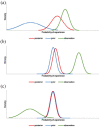Long COVID as a functional somatic symptom disorder caused by abnormally precise prior expectations during Bayesian perceptual processing: A new hypothesis and implications for pandemic response
- PMID: 37655303
- PMCID: PMC10467233
- DOI: 10.1177/20503121231194400
Long COVID as a functional somatic symptom disorder caused by abnormally precise prior expectations during Bayesian perceptual processing: A new hypothesis and implications for pandemic response
Abstract
This review proposes a model of Long-COVID where the constellation of symptoms are in fact genuinely experienced persistent physical symptoms that are usually functional in nature and therefore potentially reversible, that is, Long-COVID is a somatic symptom disorder. First, we describe what is currently known about Long-COVID in children and adults. Second, we examine reported "Long-Pandemic" effects that create a risk for similar somatic symptoms to develop in non-COVID-19 patients. Third, we describe what was known about somatization and somatic symptom disorder before the COVID-19 pandemic, and suggest that by analogy, Long-COVID may best be conceptualized as one of these disorders, with similar symptoms and predisposing, precipitating, and perpetuating factors. Fourth, we review the phenomenon of mass sociogenic (functional) illness, and the concept of nocebo effects, and suggest that by analogy, Long-COVID is compatible with these descriptions. Fifth, we describe the current theoretical model of the mechanism underlying functional disorders, the Bayesian predictive coding model for perception. This model accounts for moderators that can make symptom inferences functionally inaccurate and therefore can explain how to understand common predisposing, precipitating, and perpetuating factors. Finally, we discuss the implications of this framework for improved public health messaging during a pandemic, with recommendations for the management of Long-COVID symptoms in healthcare systems. We argue that the current public health approach has induced fear of Long-COVID in the population, including from constant messaging about disabling symptoms of Long-COVID and theorizing irreversible tissue damage as the cause of Long-COVID. This has created a self-fulfilling prophecy by inducing the very predisposing, precipitating, and perpetuating factors for the syndrome. Finally, we introduce the term "Pandemic-Response Syndrome" to describe what previously was labeled Long-COVID. This alternative perspective aims to stimulate research and serve as a lesson learned to avoid a repeat performance in the future.
Keywords: Bayesian predictive processing; Long-COVID; functional syndrome; mass sociogenic illness; somatic symptom disorder.
© The Author(s) 2023.
Conflict of interest statement
The author(s) declared no potential conflicts of interest with respect to the research, authorship, and/or publication of this article.
Figures


References
-
- Gibney RTN, Blackman C, Fan E, et al.. COVID-19 pandemic: the impact on Canada’s intensive care units. An RSC Policy Briefing. Royal Society of Canada. June 2022. Available at: https://rsc-src.ca/en/covid-19-policy-briefing-recent/covid-19-pandemic-... (Accessed 1 May, 2023).
-
- Manhas KP, Kania-Richmond A, Cunningham C, et al.. For the COVID-19 scientific advisory group rapid evidence report. Updated review of prolonged symptoms after acute COVID-19 infection. AHS July 12, 2021. https://www.albertahealthservices.ca/assets/info/ppih/if-ppih-covid-19-s... (accessed 1 May 2023).
Publication types
LinkOut - more resources
Full Text Sources

